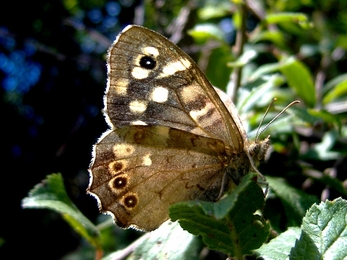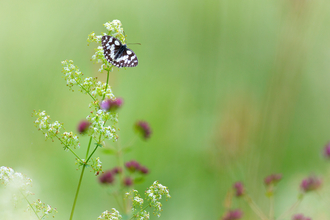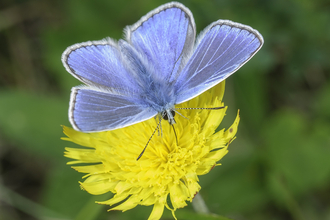Woodland butterflies
See some of the rarest butterflies in Britain. Look to the skies for canopy-dwelling butterflies like purple emperor and purple hairstreak, scanning the treetops for the chance to spot them in flight. Bramble patches are good spots for passing white admirals who are partial to the blossoms, and are a favourite for the black, brown and white-letter hairstreaks. While many of the UK's 59 butterfly species are in decline, a handful of woodland butterflies are bucking the trend, including the silver-washed fritillary, white admiral, and speckled wood butterflies, who are all expanding their ranges.
Some searching may be needed for these specialists, but the reward makes the effort worthwhile
Find butterflies in a woodland near you
Take a look through our list below to find a woodland near you. Our highlight is Warton Crag in Lancashire: an excellent site for visiting lepidopterists. Home to four species of fritillaries, including the rare high brown fritillary, which is best looked for in July.
North
- Cumbria, Howe Ridding Wood
- Durham, Hardwick Dene
- Durham, Milkwellburn Wood
- Lancashire, Warton Crag
- Northumberland, Juliet’s Wood
- Yorkshire, Brockadale
Midlands
- Northamptonshire, Glapthorn Cow Pasture (good for black hairstreak)
- Nottinghamshire, Eaton and Gamston Woods
- Shropshire, Jones’ Rough
- Warwickshire, Alvecote Meadows
- Warwickshire, Draycote Meadows
- Warwickshire, Knowle Hill
- Worcestershire, Grafton Wood (good for brown hairstreak)
- Worcestershire, Monk Wood
South
- Avon, Weston Big Wood
- Buckinghamshire, Homefield Wood
- Buckinghamshire, Whitecross Green Wood
- Cornwall, Pendarves Wood
- Devon, Marsland
- Gloucestershire, Siccaridge Wood
- Hampshire, Pamber Forest
- Hampshire, Roydon Woods
- Kent, East Blean Wood (one of the best places for heath fritillary)
- Dorset, Powerstock Common
- London, Sydenham Hill Wood
- Somerset, King’s Castle Wood
- Surrey, Norbury Park
- Surrey, Rodborough Common
- Wiltshire, Blackmoor Copse
East
- Bedfordshire, King’s Wood and Rammamere Heath
- Cambridgeshire, Brampton Wood
- Essex, Thrift Wood
- Hertfordshire, Balls Wood
- Norfolk, Foxley Wood
- Suffolk, Bradfield Woods
Wales
- Powys, Gilfach
- Powys, Ystradfawr
Scotland
- Argyll, Shian Wood
- Lanarkshire, Forest Wood
Northern Ireland
- Antrim, Glenarm
What to look out for
Almost all our fritillaries are on the decline, and species have particular plant requirements for their caterpillars: heath fritillary prefers the uncommon cow-wheat, while devil’s-bit scabious is the marsh fritillary's favourite. Violets attract pearl-bordered, small pearl-bordered, silver-washed, dark green, and high brown. Our rarer hairstreaks lay their eggs on mature blackthorn scrub along hedgerows or on the edge of woodland, while the delicate wood white requires vetches and vetchlings along sunny woodland rides.
Sunny glades, rides and woodland edges are some of the best places to look for a variety of species. Bringing along your binoculars and locating the larval foodplant of specialist butterflies can make searching that bit easier. You can download our guide to 40 great nature reserves that offer a chance to see some of these beautiful butterflies for some more detailed information, and why not take along a copy of our children’s woodland butterfly spotter sheet?
If you can't get to these places
Our woodland rarities are restricted to their own specially managed sites, but if you can't get to them, why not chase butterflies vicariously - read Patrick Barkham’s ‘The Butterfly Isles: A Summer In Search Of Our Emperors And Admirals’.
More wildlife experiences
From seeing colourful wildflowers to spotting magnificent birds of prey, we can help you get closer to wildlife across the UK.








